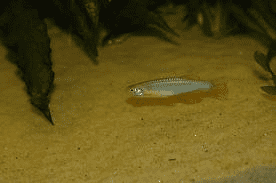
Common name: Pearl Danio, Spotted Danio
Scientific name: Danio Albolineatus
Average Adult Fish Size: 2 inches / 6 cm
Place of Origin: Burma, Sumatra, Thailand
Typical Tank setup: A planted tank with rockwork, driftwood/bogwood and strong current. Plenty of open swimming space is preferential too.
Recommended Minimum Aquarium Capacity: 20 gallon / 80 litre
Compatibility: Pearl Danios are well suited for community aquariums, and get along with any peaceful fish. They are tolerant of a wide range of water conditions, which also make them suited to combining with a variety of other fish. As a schooling fish, they should be kept in groups of at least four, preferably more. Males will show their best colours if there is at least one female present.
Temperature: 64 – 74 Deg F / 18 – 24 Deg C
Water chemistry: pH 6.5 – 7.0
Feeding: Pearls will accept all types of live, frozen, and flake food. In nature their diet consists primarily of insects and zooplankton. To maintain health, feed good quality tropical flake or granulated food, as well as frozen and live foods such as Tubifex, mosquito larvae, brine shrimp and Daphnia.
Sexing: Unlike many tropical fish, the female Pearl Danios are larger overall, and fuller-bodied than the makes. It is not unusual for females to be more robust than the males. Males are smaller, slimmer, and more brightly colourful. The males often show a red tint along the ventral aspect
Breading: Pearl Danios are an easy to breed egg laying fish. The female is fuller-bodied, while males are noticeably smaller and more colourful. Like other Danios, when breeding pairs form they are very loyal. The breeding tank should be warm, 79-86F(26-30C), and the water level shallow, about four to six inches (10-15 cm). Fine-leaved plants should be provided, either floating or planted in a group. Marbles make an excellent substrate that will allow stray eggs to fall out of the reach of hungry adult fish.
Pearl Danios will spawn as pairs or in a school. Half as many females as males should be placed in the breeding tank several days before introducing the males. Once the males are added, pairs will form and leave the group to scatter eggs among the plants. Remove the adults as soon as spawning is completed, otherwise they consume their own eggs.
Keep the tank dark while the eggs develop, to prevent fungal growth. The fry will emerge in 36 to 48 hours and should be fed freshly hatched brine shrimp or infusoria. Young grow rapidly and will be free-swimming in six to seven days. They may be raised on finely ground dry food or commercially prepared fry food.
Additional Information: If you’ve seen a Pearl Danio you know the iridescent colours it’s named for make it one of the most attractive freshwater fish. Its pearly blue-violet hued body is accented by an orange-red stripe running from tail to mid-body. Males are smaller, slimmer, and more colourful, often showing a red tint along the ventral aspect. A yellow ochre colour variant, known as the ‘Yellow Danio’, is available in some locations.
Pearl Danios have a forked tail, paired barbels, and reach a maximum length of two inches (6 cm). They are live for approximately five years. An extremely hardy and easy to care for fish, Pearls make an excellent beginner fish. They are peaceful, and well suited to community tanks with other small to medium sized fish. Like others of the Danio family, Pearls live in schools and should always be kept in groups of four or more.


Related Posts
Croaking Gourami – Trichopsis vittatus
Benthochromis Tricoti
Large-eyed Mouthbrooder – Callochromis Macrops